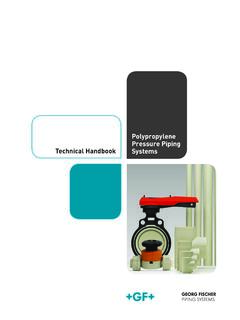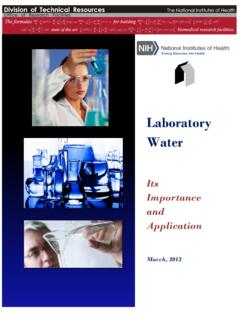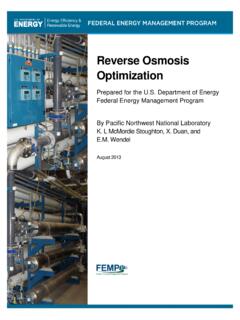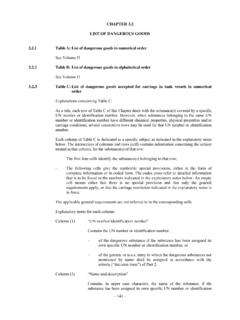Transcription of A GUIDE TO THE ISO 8573 SERIES COMPRESSED AIR …
1 HIGH QUALITY COMPRESSED AIR. A GUIDE TO THE ISO 8573 SERIES . COMPRESSED AIR QUALITY STANDARD. PARTICULATE. CONTAMINATION >. THIS DOCUMENT PROVIDES AN INTRODUCTION TO THE ISO 8573 SERIES OF. COMPRESSED AIR CONTAMINATION. INTERNATIONAL STANDARDS WHICH COVER COMPRESSED AIR PURITY AND TEST. METHODS, AS WELL AS THE PURIFICATION EQUIPMENT REQUIRED TO ACHIEVE. THE STANDARDS. To understand the international standards for COMPRESSED air quality, we must first of all understand sources of contamination, the individual contaminants found within a COMPRESSED air system and the problems that contaminants can cause: Sources of contamination in a COMPRESSED air system Contaminants in a COMPRESSED air system can generally be attributed to the following: The quality of air being drawn into the compressor Air compressors draw in large volumes of air from the surrounding atmosphere containing large numbers of airborne contaminants. The type and operation of the air compressor The air compressor itself can also add contamination, from wear particles to coolants and lubricants.
2 COMPRESSED air storage devices and distribution systems The air receiver and system piping are designed to store and distribute the COMPRESSED air. As a consequence they will also store the large amounts of contamination drawn into the system . Additionally, piping and air recievers will also cool the moist COMPRESSED air forming condensate which causes damage and corrosion. Types of contamination found in a COMPRESSED air system Atmospheric Dirt Micro-organisms Atmospheric air in an industrial environment typically Bacteria and viruses will also be drawn into the COMPRESSED contains 140 million dirt particles for every cubic metre of air system through the compressor intake and warm, moist air. 80% of these particles are less than 2 microns in size air provides an ideal environment for the growth of micro- 1/2. and are too small to be captured by the compressor intake organisms. Ambient air can typically contain up to 3,850. filter, therefore passing directly into the COMPRESSED air micro-organisms per cubic metre.
3 If only a few micro- system . organisms were to enter a clean environment, a sterile process or a production system , enormous damage could be Water Vapour, Condensed Water and Water Aerosols caused that not only diminishes product quality, but may Atmospheric air contains water vapour (water in a gaseous even render a product entirely unfit for use and subject to form). The ability of COMPRESSED air to hold water vapour is recall. dependent upon it's temperature. The higher the temperature, the more water vapour that can be held by the Liquid Oil and Oil Aerosols air. During compression, the air temperature is increased Most air compressors use oil in the compression stage for significantly, which allows it to easily retain the incoming sealing, lubrication and cooling. During operation, moisture. After the compression stage, air is normally lubricating oil is carried over into the COMPRESSED air system cooled to a usable temperature. This reduces the air's as liquid oil and aerosols.
4 This oil mixes with water vapour in ability to retain water vapour, resulting in a proportion of the air and is often very acidic, causing damage to the the water vapour being condensed into liquid water which COMPRESSED air storage and distribution system , production is removed by a condensate drain fitted to the compressor equipment and final product. after-cooler. The air leaving the after-cooler is now 100%. saturated with water vapour and any further cooling of the Oil Vapour air will result in more water vapour condensing into liquid In addition to dirt and water vapour, atmospheric air also water. Condensation occurs at various stages throughout contains oil in the form of unburned hydrocarbons. The the system as the air is cooled further by the air receiver, unburned hydrocarbons drawn into the compressor intake piping and the expansion of air in valves, cylinders, tools as well as vapourised oil from the compression stage of a and machinery. The condensed water and water aerosols lubricated compressor will carry over into a COMPRESSED air cause corrosion to the storage and distribution system , system where it can cool and condense, causing the same damage production equipment and the end product.
5 It also contamination issues as liquid oil. Typical oil vapour reduces production efficiency and increases maintenance concentrations can vary between and per cubic costs. Water in any form must be removed to enable the metre of ambient air. system to run correctly and efficiently. Rust and Pipescale Rust and pipescale can be found in air receivers and the piping of wet systems (systems without adequate purification equipment) or systems which were operated wet prior to purification equipment being installed. Over time, this contamination breaks away to cause damage or blockage in production equipment which can also contaminate final product and processes. WATER. CONTAMINATION >. ASK MOST MAINTENANCE OR PRODUCTION ENGINEERS WHAT IS THE MAJOR. PURIFICATION TECHNOLOGIES. CONTAMINANT FOUND IN ANY COMPRESSED AIR system , AND THE ANSWER. WOULD PROBABLY BE OIL. IN REALITY, OIL IS NOT THE MAJOR PROBLEM EVERYONE. THINKS IT IS, AS THE MOST PROLIFIC CONTAMINANT IS IN FACT WATER. Up to of the total liquid contamination found in a COMPRESSED air system is water.
6 Oil is perceived to cause the most problems as it is seen emanating from open drain points and exhausting valves, however, in the majority of instances, it is actually oily condensate (oil mixed with water) that is being observed. How much water can be found in a typical COMPRESSED air system ? The amount of water in a COMPRESSED air system is staggering. A small (100 cfm) compressor and refrigeration dryer combination, operating for 4000 hours in typical Northern European climatic conditions can produce approximately 10,000 litres or 2,200 gallons of liquid condensate per year. If the compressor is oil lubricated with a typical 2 mg/m3 (2ppm) oil carryover, then although the resulting condensate would visually resemble oil, oil would in fact account for less than of the overall volume and it is this resemblance to oil to which a false association is made. The example above assumes uses a small compressor to highlight the large volume of condensate produced. If a COMPRESSED air system was operated in warmer, more humid climates, or with larger compressors installed, running for longer periods, the volume of condensate would increase significantly.
7 Contamination and Types of Compressor It is often believed that the level of COMPRESSED air purification equipment required in a system is dependent upon the type of compressor used. Contamination in a COMPRESSED air system originates from many sources and is not related solely to the compressor or it's lubricants. No matter what compressor type is selected, adequate filtration and separation products will be required to remove the large volume of dirty contaminated water as well as the dirt, rust, pipescale and microbiological contamination in the system . COMPRESSED Air and It's Purification Having identified the different types of contamination that can be found within a COMPRESSED air system , we can now examine the purification technologies available for it's removal. 3/4. Coalescing Filters Refrigeration Dryers Coalescing filters are probably the most important items of Refrigeration dryers work by cooling the air, so are limited to purification equipment in any COMPRESSED air system .
8 They are positive pressure dewpoint ratings to prevent freezing of the designed to remove oil and water aerosols using mechanical condensed liquid. Ideal for general purpose applications, they filtration techniques and have the additional benefit of removing typically provide pressure dewpoints of +3 C, +7 C or +10 C pdp. solid particulate to very low levels (as small as in size). Refrigeration dryers are not suitable for installations where piping Installed in pairs, most users believe one to be an oil removal filter is installed in ambient temperatures below the dryer dewpoint and the other to be a particulate filter, when in fact, the pair of filters systems with external piping . both perform the same function. The first filter, a general purpose filter is used to protect the high efficiency filter against bulk Important Note Regarding COMPRESSED Air Dryers contamination. This dual filter' installation ensures a continuous As adsorption and refrigeration dryers are designed to remove only supply of high quality COMPRESSED air with low operational costs and water vapour and not water in a liquid form, they require the use of minimal maintenance time.
9 Coalescing filters to work efficiently. Water Separators Adsorption (Activated Carbon) Filters Used to protect coalescing filters in systems where excessive Oil vapour is simply oil in a gaseous form and as with water vapour cooling takes place in distribution piping . Water Separators will will pass through a coalescing filter just as easily as the COMPRESSED remove in excess of 90% of bulk liquid contamination. air itself. Therefore, oil vapour removal filters must be employed as these provide a large bed of activated carbon adsorbent for the Adsorption (Desiccant) Dryers effective removal of oil vapour, providing the ultimate protection Water vapour is water in a gaseous form and is removed from against oil contamination. COMPRESSED air using a dryer, with dryer performance being Dust Removal Filters measured as pressure dewpoint. Adsorption or desiccant dryers Dust removal filters are used for the retention of particulates when remove moisture by passing air over a regenerative adsorbent no liquid is present.
10 They usually provide identical particulate material which strips the moisture from the air. This type of dryer is removal performance to the equivalent coalescing filter and use the extremely efficient and typical pressure dewpoint ratings are -40 C. same mechanical filtration techniques to provide up to or -70 C pdp. This means that for water vapour to condense into a particle removal efficiency. For absolute particulate retention (100%. liquid, the air temperature would have to drop below -40 C or -70 C. respectively (the actual air temperature after an adsorption dryer is at a given size), a sieve retention membrane filter must be used. not the same as it's dewpoint). Micro-biological (Sterile) Filters Absolute removal of solid particulates and micro-organisms is Beneficially, a pressure dewpoint of -26 C or better will not only performed by a sieve retention or membrane filter. They are often prevent corrosion, but will also inhibit the growth of micro- referred to as sterile air filters as they also provide sterilised organisms within the COMPRESSED air system .








